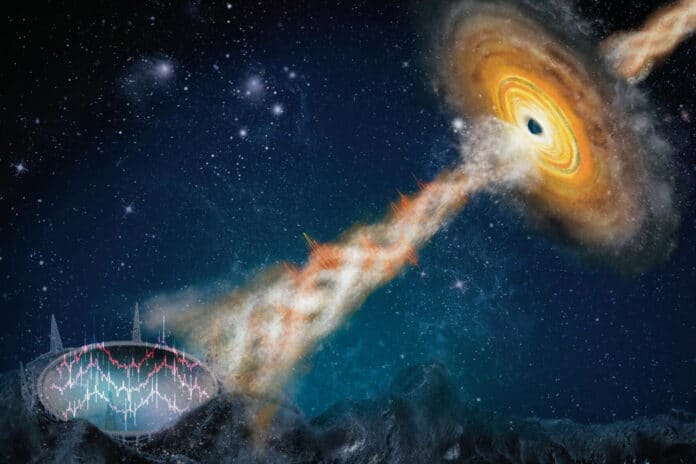Stellar-mass black holes with masses of about 10 suns indicate their existence by consuming components from the companion stars. In rare cases, supermassive black holes gather at the core of certain galaxies to create bright, compact regions known as quasars, which have masses that are millions to billions of times greater than our sun. Microquasars are a subclass of stellar-mass black holes that can eject highly magnetized plasma jets.
A new study by an international team of scientists reported on the Galactic microquasar dubbed GRS 1915+105. The team revealed a microquasar system’s features that have never been seen before.
Scientists discovered a quasi-periodic oscillation (QPO) signal in the radio band for the first time from any microquasar system, using Five-hundred-meter Aperture Spherical radio Telescope (FAST) in China. Astronomers use QPOs to understand how stellar systems like black holes function.
Wei Wang, a professor at China’s Wuhan University who led the team that made the discovery, said, “The peculiar QPO signal has a rough period of 0.2 seconds or a frequency of about 5 Hertz. Such a signal does not always exist and only appears under special physical conditions. Our team was lucky to catch the signal twice — in January 2021 and June 2022, respectively.”
UNLV astrophysicist Bing Zhang reported, “This unique feature may provide the first evidence of activity from a “jet” launched by a Galactic stellar-mass black hole. Under certain conditions, some black hole binary systems launch a jet — a mix of parallel beams of charged matter and a magnetic field that moves swiftly approaching the speed of light.”
“In accreting black hole systems, X-rays usually probe the accretion disk around the black hole while radio emission usually probes the jet launched from the disk and the black hole. The detailed mechanism to induce temporal modulation in a relativistic jet is not identified. Still, one plausible mechanism would be that the jet is underlying precession, which means the jet direction is regularly pointing towards different directions and returns to the original direction once every about 0.2 seconds.”
“A misalignment between the spin axis of the black hole and its accretion disk (extremely hot, bright spinning gasses surrounding the black hole) could cause this effect, which is a natural consequence of a dragging of spacetime near a rapidly spinning black hole.”
Journal Reference:
- Tian, P., Zhang, P., Wang, W. et al. Subsecond periodic radio oscillations in a microquasar. Nature (2023). DOI: 10.1038/s41586-023-06336-6
